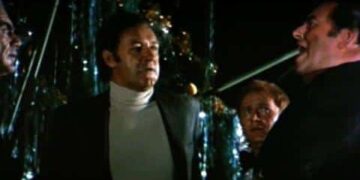Suburra: Blood on Rome is a thrilling crime novel that has been masterfully adapted into a riveting TV series. This captivating story has managed to capture the attention of countless readers and viewers worldwide. As a fan who has experienced both the book and the series, I can attest to the mesmerizing allure of Suburra’s dark and gritty narrative.
The book, penned by the brilliant duo Giancarlo De Cataldo and Carlo Bonini, presents a gripping tale of corruption, organized crime, and political intrigue. Similarly, the TV series, produced by Italian broadcaster RAI and available on Netflix, does a fantastic job of translating this intricate narrative onto the screen.
However, as with any adaptation, there are bound to be differences between the two mediums. Let’s delve into the nuances of Suburra: Blood on Rome, exploring the disparities and similarities between the bestselling book and its TV series counterpart.
Overview of the Bestselling Book and TV Series
The book summary of Suburra: Blood on Rome is a tale of corruption, crime, and political machinations. Set in Rome, it exposes the city’s underbelly, revealing a web of illicit activities and deceptions. The narrative is intricate, weaving multiple plotlines into a cohesive and compelling story. It is a story that leaves readers both horrified and fascinated, unable to tear themselves away from the gritty reality it presents.
The TV series summary, on the other hand, is a visual representation of this narrative. It captures the essence of the book, presenting it in a format that is just as captivating, if not more so. The series brings the characters and their stories to life, allowing viewers to experience the narrative in a more immersive way.
Despite the differences in format, both the book and the TV series share a common goal: to expose the corruption that pervades Rome and the individuals who perpetuate it.
Plot Summary of The Book
In the book, Rome is presented as a city steeped in corruption. The narrative revolves around several characters, each with their own agendas and motivations. At the center of it all is a controversial land deal that has the potential to alter the city’s landscape and the balance of power.
Among the key figures are a corrupt politician, a ruthless mob boss, a cunning lawyer, and a pair of young thugs. As their paths intertwine, a game of cat and mouse ensues, with each character vying for control and dominance.
The tension escalates as the stakes rise, leading to a climactic confrontation that exposes the depth of corruption in the city. The book ends on a chilling note, leaving readers to ponder the implications of the story long after they’ve turned the last page.
Plot Summary of The TV Series
The TV series follows a similar plot, but with some notable differences. The storyline is expanded to include additional characters and subplots, adding more depth and complexity to the narrative.
Like the book, the series focuses on a controversial land deal and the characters involved in it. However, it delves deeper into their backgrounds and relationships, providing viewers with a more intimate understanding of their motivations and actions.
The series also takes a more cinematic approach to the story, utilizing visual storytelling techniques to enhance the narrative’s impact. The climax is even more dramatic, with a shocking twist that leaves viewers eagerly anticipating the next episode.
When and Where The Story Takes Place
The story of Suburra: Blood on Rome takes place in Rome, specifically in the district of Suburra. This historic neighborhood is depicted as a hotbed of corruption, where crime and politics intersect.
In the book, the story unfolds over several days, leading up to a momentous event that changes the course of the characters’ lives. The narrative provides a detailed account of the events, painting a vivid picture of the city and its inhabitants.
The TV series, on the other hand, spans a longer timeframe. It covers several weeks, allowing viewers to witness the gradual escalation of the conflict. The setting is also more expansive, featuring a variety of locations within and beyond Suburra.
Exploring the Key Locations in the Book and TV Series
The locations and where the story is set play a crucial role in Suburra: Blood on Rome. They serve as the backdrop for the narrative, contributing to the story’s dark and gritty atmosphere.
In the book, the action primarily takes place in Suburra, a district known for its history of crime and corruption. Other key locations include the city’s political institutions and the luxurious villas of the city’s elite.
The TV series expands on these locations, bringing them to life with stunning cinematography. It showcases the stark contrast between the decaying streets of Suburra and the opulent residences of Rome’s upper class.
Introduction to The Main Characters
The cast of Suburra: Blood on Rome is as diverse as it is complex. At the forefront are Aureliano Adami and Alberto ‘Spadino’ Anacleti, two young men who find themselves drawn into the city’s criminal underworld.
Aureliano, the son of a powerful crime family, is a volatile and impulsive individual. His reckless actions often put him at odds with his family and their allies. Spadino, on the other hand, is a member of the Anacleti clan, a rival crime family. Despite his initial reluctance, he becomes deeply involved in the city’s power struggle.
In addition to these main characters, the story features a host of supporting characters, each with their own unique traits and story arcs.
Guest Stars in The TV Series
The TV series boasts an impressive lineup of guest stars, each contributing to the richness of the story. Among them are prominent Italian actors like Claudia Gerini, who plays the ambitious politician, Sara Monaschi, and Filippo Nigro, who portrays the cunning lawyer, Amedeo Cinaglia.
These guest stars bring their characters to life, adding depth and complexity to the narrative. Their performances are a testament to the talent and dedication that went into creating the series.
Memorable Quotes from Suburra: Blood on Rome
Throughout Suburra: Blood on Rome, there are numerous quotes that resonate with viewers and readers. Whether it’s Aureliano’s defiant challenge to his family, or Spadino’s poignant reflection on his fate, these lines serve as memorable reminders of the story’s themes and messages.
One such quote comes from Cinaglia, who states, “In politics, it’s not about what’s true or false. It’s about what people believe.” This quote aptly captures the essence of the series, highlighting the manipulative nature of the political world.
The Soundtrack by Scott Morgan and Piotta
The soundtrack of Suburra: Blood on Rome is a noteworthy aspect of the series. Composed by Scott Morgan and Italian rapper Piotta, the music enhances the show’s atmosphere, setting the tone for each scene.
Morgan’s melodies are haunting and evocative, reflecting the dark undertones of the narrative. Piotta’s contributions, on the other hand, are energetic and raw, mirroring the chaos and tension that pervade the series.
Curiosities and Behind-The-Scenes Information
Delving into the behind-the-scenes information of Suburra: Blood on Rome can be as intriguing as the show itself. From the meticulous research that went into crafting the series to the challenges faced during production, these curiosities add an extra layer of depth to the narrative.
For instance, the series was shot on location in Rome, utilizing real-life settings to achieve authenticity. Additionally, the show’s creators consulted with local law enforcement and criminal experts to ensure accuracy in their depiction of the city’s underworld.
Tips for Cosplay and Dressing like Aureliano Adami and Alberto ‘Spadino’ Anacleti
If you’re a fan of Suburra: Blood on Rome and want to emulate the style of characters like Aureliano Adami or Alberto ‘Spadino’ Anacleti, there are certain tips you can follow. For Aureliano, think leather jackets, dark jeans, and rugged boots, while for Spadino, opt for more flamboyant outfits, complete with eye-catching jewelry.
Keep in mind that dressing like these characters is more than just about the clothes. It’s also about embodying their attitudes and personalities. So, channel your inner Aureliano or Spadino and step into their world!
Biography and Notable Works of Giancarlo De Cataldo and Carlo Bonini
Giancarlo De Cataldo and Carlo Bonini are the brilliant minds behind Suburra: Blood on Rome. De Cataldo is a judge and writer, known for his crime novels and essays. Bonini, on the other hand, is a journalist and author, recognized for his investigative reporting and non-fiction works.
Together, they have created a compelling narrative that has captivated readers and viewers alike. Their collaboration on Suburra: Blood on Rome is a testament to their talent and creativity.
Five Best Works by Giancarlo De Cataldo and Carlo Bonini
In addition to Suburra: Blood on Rome, De Cataldo and Bonini have produced several other notable works. These include “Romanzo Criminale,” a crime novel written by De Cataldo and adapted into a successful TV series, and “Acab,” a gritty exploration of police brutality co-authored by Bonini.
Other works worth mentioning are “Nelle mani giuste,” a thought-provoking novel by De Cataldo, and “La guerra al tempo di Internet,” a revealing examination of cyber warfare by Bonini. Lastly, “Non esiste saggezza,” another novel by De Cataldo, is a philosophical exploration of life and death.
Similar Media to Suburra: Blood on Rome
If you enjoyed Suburra: Blood on Rome, there are several other media that might pique your interest. Series like “Gomorrah” and “Narcos” offer similar themes of crime and corruption. Movies like “The Godfather” and “Goodfellas” also delve into the world of organized crime.
In terms of books, “The Cartel” by Don Winslow and “The Night Manager” by John le Carré provide gripping narratives of crime and intrigue. These media, like Suburra: Blood on Rome, offer compelling stories that will keep you on the edge of your seat.
Five Other Works by Giancarlo De Cataldo and Carlo Bonini
Beyond Suburra: Blood on Rome, De Cataldo and Bonini have other works that are worth exploring. These include “I traditori,” “La forma della paura,” and “Io sono il libanese” by De Cataldo, and “La banda della Magliana” and “The Dark Side of Rome” by Bonini.
Each of these works offers a unique perspective on crime, corruption, and society, reflecting the authors’ deep understanding of these issues. They are essential reads for anyone interested in the darker aspects of human nature.
Similar Media with a Similar Plot to Suburra: Blood on Rome
If you’re looking for media with plots similar to Suburra: Blood on Rome, there are several options to consider. Series like “Breaking Bad” and “The Sopranos” feature complex characters embroiled in the world of crime. Movies like “Scarface” and “Casino” depict the rise and fall of criminal empires.
In terms of books, “The Godfather” by Mario Puzo and “American Tabloid” by James Ellroy explore the intersection of crime and politics. These media, like Suburra: Blood on Rome, delve into the darker side of society, revealing a world that is both fascinating and terrifying.
Travel Guide to Visit the Locations Featured in Suburra: Blood on Rome
If you’re a fan of Suburra: Blood on Rome and planning a trip to Rome, why not visit some of the locations featured in the series? From the historic district of Suburra to the opulent villas of the city’s elite, these locations offer a glimpse into the world of the series.
Besides Suburra, other locations worth visiting include the Colosseum, the Roman Forum, and the Pantheon. These iconic landmarks provide a fascinating look into Rome’s rich history and culture.
Conclusion
In conclusion, Suburra: Blood on Rome is a captivating narrative that explores the dark underbelly of Rome. Whether you’re a fan of the book, the TV series, or both, there’s no denying the impact of this compelling story. It’s a tale that exposes the corruption that pervades society, challenging us to question our perceptions and assumptions.
So, whether you’re planning to dress up like Aureliano or Spadino, eager to explore the works of De Cataldo and Bonini, or planning a trip to Rome to visit the locations featured in the series, Suburra: Blood on Rome offers a wealth of experiences that are as diverse and complex as its narrative.













